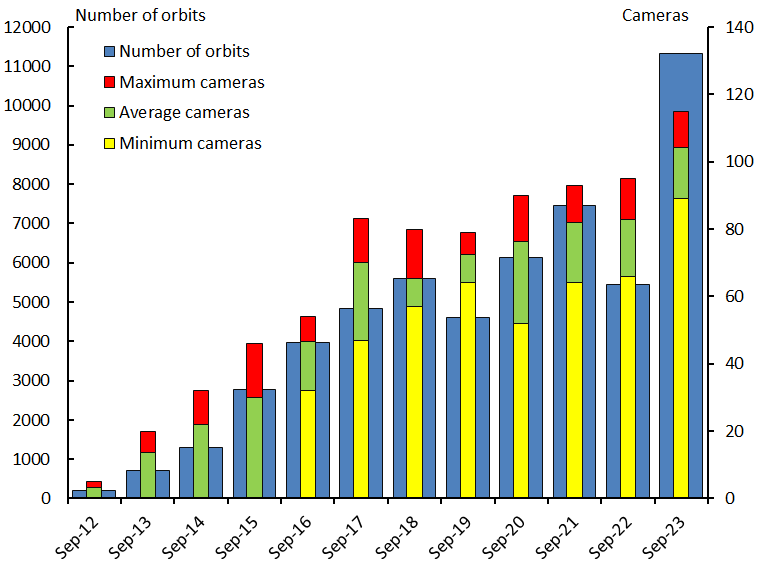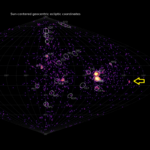Abstract: A summary of the activity of the CAMS-BeNeLux network during the month of September 2023 is presented. This month was good for 42968 multi-station meteors resulting in 11331 orbits.
Introduction
In September, sporadic meteor activity is already quite high, and as nights get longer in this time of the year, this is always a prelude to fascinating nights, even if there are no major streams active.
September 2023 statistics
September got off with very sunny and warm weather. The first ten nights yielded a very rich harvest of 5191 simultaneous meteors. In the nights between September 4 and 10, more orbits were collected each night than on any other September night in the past 11 years.
Although the weather got less sunny after the middle of the month, we could collect orbits in every single September night. In just 5 nights during this month, less than 100 orbits were obtained, a very special situation.
The least productive night was September 28–29 with 17 orbits collected by 95 cameras. The highest number on September 6–7 was 747 orbits.
CAMS-BeNeLux collected data of 42968 multi-station meteors this month, resulting in a total of 11331 orbits. By far the best result for a September month in the history of our network (Figure 1). 61.1% of all orbits were collected from more than 2 stations. This is more or less the same percentage as in recent months.
We could welcome Stef Vancampenhout as a new participant in our network. He operates his RMS-camera (CAMS number 3842) from Vorselaar in the northern parts of Belgium. His data gives a better coverage for the northwestern parts of the BeNeLux.
On average 104 cameras were active every night, at least 89 cameras on September 19–20. The highest number was 115 cameras on September 14–15.
Table 1 – Number of orbits and active cameras in the BeNeLux during the month of September in the period 2012–2023.
| Year | Nights | Orbits | Stations | Max. Cams | Min. Cams | Mean Cams |
| 2012 | 18 | 209 | 5 | 5 | 3.4 | |
| 2013 | 19 | 712 | 9 | 20 | 13.7 | |
| 2014 | 27 | 1293 | 14 | 32 | 22.0 | |
| 2015 | 29 | 2763 | 15 | 46 | 30.0 | |
| 2016 | 30 | 3982 | 19 | 54 | 32 | 46.5 |
| 2017 | 29 | 4839 | 22 | 83 | 47 | 70.2 |
| 2018 | 28 | 5606 | 20 | 80 | 57 | 65.4 |
| 2019 | 29 | 4609 | 20 | 79 | 64 | 72.3 |
| 2020 | 26 | 6132 | 24 | 90 | 52 | 76.2 |
| 2021 | 30 | 7457 | 26 | 93 | 64 | 82.0 |
| 2022 | 30 | 5446 | 30 | 95 | 66 | 82.8 |
| 2023 | 30 | 11331 | 37 | 115 | 89 | 104.1 |
| Total | 325 | 54379 |

Figure 1 – Comparing September 2023 to previous months of September in the CAMS-BeNeLux history. The blue bars represent the number of orbits, the red bars the maximum number of cameras capturing in a single night, the green bars the average number of cameras capturing per night and the yellow bars the minimum number of cameras.
Conclusion
In September our network collected a record number of orbits since the start of our network in 2012. This result is nearly as good as last August. But September has no major meteor showers like the Perseids, what emphasizes how special this result is.
Acknowledgement
Many thanks to all participants in the CAMS-BeNeLux network for their dedicated efforts. The CAMS-BeNeLux team was operated by the following volunteers during the month of September 2023:
Stéphane Barré (Colombey-Les-Belles, France, RMS 3907), Hans Betlem (Woold, Netherlands, Watec 3071, 3072, 3073, 3074, 3075, 3076, 3077 and 3078), Felix Bettonvil (Utrecht, Netherlands, Watec 376), Jean-Marie Biets (Wilderen, Belgium, Watec 379, 380 and 381), Ludger Boergerding (Holdorf, Germany, RMS 3801), Günther Boerjan (Assenede, Belgium, RMS 3823), Martin Breukers (Hengelo, Netherlands, Watec 320, 321, 322, 323, 324, 325, 326 and 327, RMS 319, 328 and 329), Seppe Canonaco (Genk, RMS 3818 and 3819), Pierre de Ponthiere (Lesve, Belgium, RMS 3816 and 3826), Bart Dessoy (Zoersel, Belgium, Watec 397, 398, 804, 805, 806, 3888 and RMS 3827), Tammo Jan Dijkema (Dwingeloo, Netherlands, RMS 3199), Isabelle Ansseau, Jean-Paul Dumoulin, Dominique Guiot and Christian Wanlin (Grapfontaine, Belgium, Watec 815, RMS 3814 and 3817), Uwe Glässner (Langenfeld, Germany, RMS 3800), Roel Gloudemans (Alphen aan de Rijn, Netherlands, RMS 3197), Luc Gobin (Mechelen, Belgium, Watec 3890, 3891, 3892 and 3893), Tioga Gulon (Nancy, France, Watec 3900 and 3901), Robert Haas (Alphen aan de Rijn, Netherlands, Watec 3160, 3161, 3162, 3163, 3164, 3165, 3166 and 3167), Robert Haas (Texel, Netherlands, Watec 811 and 812), Kees Habraken (Kattendijke, Netherlands, RMS 3780, 3781, 3782 and 3783), Klaas Jobse (Oostkapelle, Netherlands, Watec 3030, 3031, 3032, 3033, 3034, 3035, 3036 and 3037), Carl Johannink (Gronau, Germany, Watec 3100, 3101, 3102), Reinhard Kühn (Flatzby, Germany, RMS 3802), Hervé Lamy (Dourbes, Belgium, Watec 394 and 395, RMS 3825 and 3841), Hervé Lamy (Humain, Belgium, RMS 3821 and 3828), Hervé Lamy (Ukkel, Belgium, Watec 393 and 817), Hartmut Leiting (Solingen, Germany, RMS 3806), Horst Meyerdierks (Osterholz-Scharmbeck, Germany, RMS 3807), Koen Miskotte (Ermelo, Netherlands, Watec 3051, 3052, 3053 and 3054), Pierre-Yves Péchart (Hagnicourt, France, RMS 3902, 3903, 3904 and 3905), Eduardo Fernandez del Peloso (Ludwigshafen, Germany, RMS 3805), Tim Polfliet (Gent, Belgium, Watec 396, RMS 3820 and 3840), Steve Rau (Oostende, Belgium, RMS 3822), Steve Rau (Zillebeke, Belgium, Watec 3850 and 3852, RMS 3851 and 3853), Paul and Adriana Roggemans (Mechelen, Belgium, RMS 3830 and 3831, Watec 3832, 3833, 3834, 3835, 3836 and 3837), Philippe Schaack (Roodt-sur-Syre, Luxemburg, RMS 3952), Hans Schremmer (Niederkruechten, Germany, Watec 803), Erwin van Ballegoij (Heesh, Netherlands Watec 3148 and 3149), Stef Vancampenhout (Vorselaar, Belgium, RMS 3842), Andy Washington (Clapton, England, RMS 3702).




